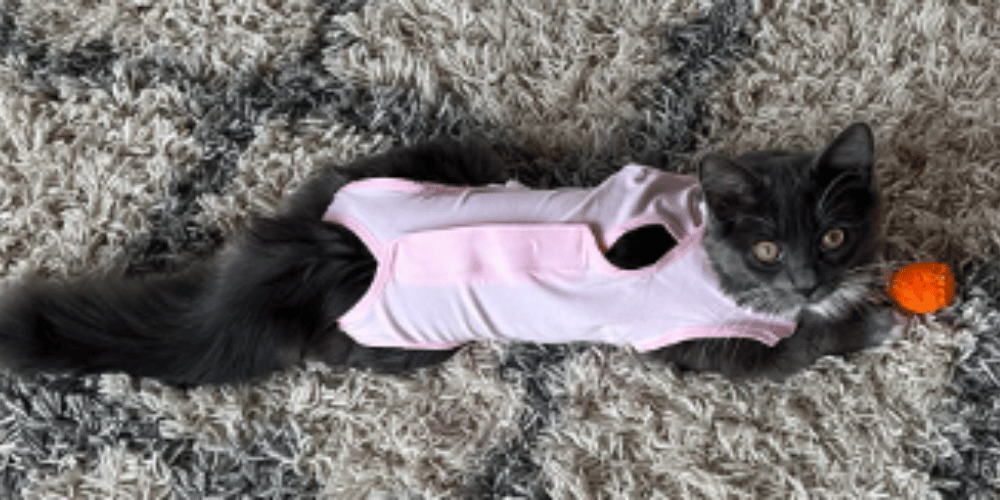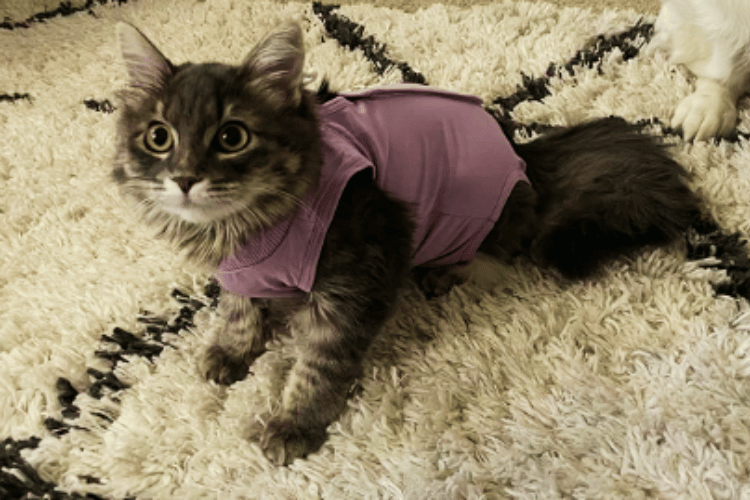If you're a cat owner facing the daunting task of post-surgery care, you may have heard of the surgery onesie - a specially designed garment that prevents cats from interfering with their wounds.
But how do these onesies affect a cat's ability to pee? In this comprehensive article, we'll answer the burning question on every cat owner's mind: Can cats pee with a surgery onesie?
We'll explore the topic from various angles, including the design and fit of the onesie, its impact on a cat's mobility and comfort, and practical tips for managing your furry friend's bathroom breaks.
So, buckle up and get ready to discover everything you need to know about cats and surgery onesies!

Understanding the Use of Surgery Onesies for Cats
Surgery onesies, also known as post-operative garments, are often used to help protect cats after they have undergone surgery. These garments are designed to fit snugly around the cat's body, covering the surgical site and preventing the cat from licking or scratching at the incision.
One common concern among cat owners is whether their cat can still pee while wearing a surgery onesie. The answer is yes, cats can urinate while wearing these garments.
Surgery onesies are designed with multiple openings, including one for the tail and one for the genitals. This design allows the cat to move around comfortably and eliminates any obstruction to their natural bodily functions.
The openings are strategically placed to ensure that the onesie does not interfere with the cat's ability to urinate or defecate.
It's important to note that it may take some time for your cat to adjust to wearing a surgery onesie. Initially, some cats may feel uncomfortable or restricted while wearing the garment. However, with time and patience, most cats will adapt to the onesie and be able to move around and use the litter box without issue.
When it comes to caring for your cat while they are wearing a surgery onesie, it's important to keep the garment clean and dry. Clean any areas that come into contact with urine or feces promptly, as this can prevent any discomfort or irritation for your cat.
It's also important to monitor your cat's behavior and ensure that they can urinate and defecate as usual.
Overall, surgery onesies can be a helpful tool for protecting your cat after a surgical procedure. These garments are designed to allow for normal bodily functions, which include urination and defecation.
With proper care and monitoring, your cat can recover comfortably while wearing a surgery onesie.

FAQs about Cats Peeing with a Surgical Onesie
It can be hard to know if a surgery onesie is the right choice for your cat's urinary needs. With so many different types of onesies on the market, it can be difficult to determine which one is best for your pet.
We've compiled a list of the most frequently asked questions about surgery onesies for cats so you can know more about these products.
From the materials used to the benefits of using a onesie, we'll help you make an informed decision about the best option for your cat's urinary health.
Can cats pee while wearing a surgical onesie?
Yes, most cats can use the litterbox while wearing a surgical onesie. These onesies are specially tailored with an opening on the back to allow cats to urinate without needing to remove the garment.
Do spayed cats sometimes experience issues with urine on their onesies?
Some cat owners have reported issues with spayed cats getting pee on their onesies. However, it's important to determine the underlying cause of this problem. It could be related to the fit of the onesie or other factors. Consulting with a veterinarian or trying different onesie options may help address this issue.
How does a surgical onesie allow cats to urinate without removing it?
Surgical onesies, such as the ones designed for post-surgery recovery, typically have a cut or opening in the back to allow female cats to urinate/excrete without needing to remove the garment. This design feature ensures convenience for both the cat and the owner.
Are there any other benefits of using a surgical onesie for cats?
Yes, surgical onesies offer several benefits for cats during recovery or after medical procedures. They can serve as an alternative to cones or bandages and protect the cat's skin. Additionally, they can help prevent excessive licking or scratching of wounds, reducing the risk of infection or complications.
Are there any other benefits of using a surgical onesie for cats?
Yes, surgical onesies offer several benefits for cats during recovery or after medical procedures. They can serve as an alternative to cones or bandages and protect the cat's skin. Additionally, they can help prevent excessive licking or scratching of wounds, reducing the risk of infection or complications.
Is urinary incontinence common after routine surgery in cats?
No, urinary incontinence is not a common issue after routine surgery in cats. Regardless of the procedure, cats should be able to urinate normally. If there are concerns about urinary issues, it's important to consult with a veterinarian for proper evaluation and advice.
Remember, while surgical onesies can be beneficial in certain situations, it's always essential to consult with a veterinarian for specific guidance and recommendations based on your cat's individual needs and circumstances.
The answer is yes! With the help of a surgery onesie, cats can pee while staying safe and comfortable.
Not only does it provide the necessary coverage and protection during surgery, but it also prevents cats from accidentally urinating on themselves or their surroundings. This makes it a great solution for cats who are undergoing surgery or have limited mobility.
So if you’re looking for a way to keep your cat safe and secure during surgery, look no further than the surgery onesie. It’s the perfect way to ensure that your cat stays dry and comfortable during the procedure. Plus, it’s an affordable and easy solution that will help make sure your cat is always protected.
Thank you for visiting LegitLists we hope this helps you make a legitimate choice!






